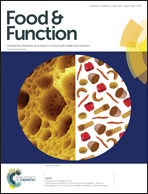Porous calcium carbonate as a carrier material to increase the dissolution rate of poorly soluble flavouring compounds†
Abstract
Two different food grade functionalised porous calcium carbonates (FCC), with different pore size and pore size distributions, were characterised and used as carrier materials to increase the dissolution rate of poorly soluble flavouring compounds in aqueous solution. The loading level was varied between 1.3% by weight (wt%) and 35 wt%, where the upper limit of 35 wt% was the total maximum loading capacity of flavouring compound in FCC based on the fraction of the total weight of FCC plus flavouring compound. Flavouring compounds (L-carvone, vanillin, and curcumin) were selected based on their difference in hydrophilicity and capacity to crystallise. Release kinetic studies revealed that all flavouring compounds showed an accelerated release when loaded in FCC compared to dissolution of the flavouring compound itself in aqueous medium. The amorphous state and/or surface enlargement of the flavouring compound inside or on FCC explains the faster release. The flavouring compounds capable of crystallising (vanillin and curcumin) were almost exclusively amorphous within the porous FCC material as determined by X-ray powder diffraction one week after loading and after storing the loaded FCC material for up to 9 months at room temperature. A small amount of crystalline vanillin and curcumin was detected in the FCC material with large pores and high flavouring compound loading (≥30 wt%). Additionally, two different loading strategies were evaluated, loading by dissolving the flavouring compound in acetone or loading by a hot melt method. Porosimetry data showed that the melt method was more efficient in filling the smallest pores (<100 nm). The main factor influencing the release rate appears to be the amorphous state of the flavouring compound and the increase in exposed surface area. The confinement in small pores prevents crystallisation of the flavouring compounds during storage, providing a stable amorphous form retaining high release rate also after storage.



 Please wait while we load your content...
Please wait while we load your content...